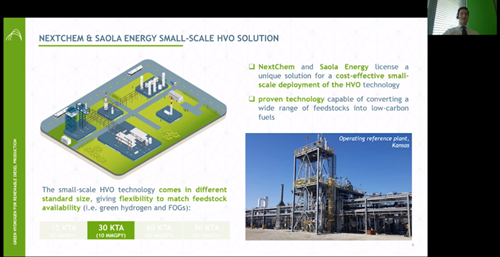News
H2Tech Solutions '21: NextChem talks green H2 for renewable diesel
Fabio Brignoli, Business Development Specialist at NextChem, Maire Tecnimont's energy transition group, discussed hydrogen solutions for renewable fuel production on Day 1 of H2Tech's H2Tech Solutions virtual event.
"Our vision is not about competition between green and blue hydrogen," Brignoli noted. "If we want to be able to kick-start the low-carbon hydrogen economy at scale, we will need to see all the low-carbon hydrogen production technologies as complimentary technologies, rather than competing."
With that caveat, Brignoli reviewed the large-scale green hydrogen production chain and noted its limiting factors. Renewable energy sources can be expensive, although costs are coming down; renewable energy is also discontinuous, as it relies on weather patterns, which places limits on electrolyzers for green hydrogen production. At present, high CAPEX for electrolyzers and a low utilization factor are other limiting factors. A limited existing infrastructure and high costs for transporting hydrogen contribute to a high levelized cost for green hydrogen.
"So, what can we do today to make green hydrogen feasible?" said Brignoli. "We need to find a way to kick-start the economies of scale to help reduce all the costs involved in the value chain, and we need to find an economic sense for green hydrogen projects by focusing on industrial applications and recognizing a premium on the green attributes of the molecule."
Green hydrogen is well suited for specific and small-scale applications. For example, the hydrogen used in the process of producing renewable diesel from hydrogenated vegetable oils normally comes from steam methane reforming (SMR)—also known as gray hydrogen. If green hydrogen is used instead, as in NextChem's ultra-low-carbon renewable diesel production (HVO) process, then it increases the value and environmentally friendliness of the renewable diesel.
A sustainable source of feedstock must be secured, which means that smaller volumes of local feedstock should be taken advantage of for the HVO plant, Brignoli noted. Replacing the SMR with an electrolyzer will also eliminate the emission of non-biogenic CO2 from the production process. A demonstration small-scale HVO plant is currently in operation in Kansas, U.S., jointly licensed by NextChem and Saola Energy.

The H2Tech Solutions virtual conference runs from 18–19 May. Please visit www.H2-TechSolutions.com to view the event agenda and register for live and on-demand access to the speaker presentations!

